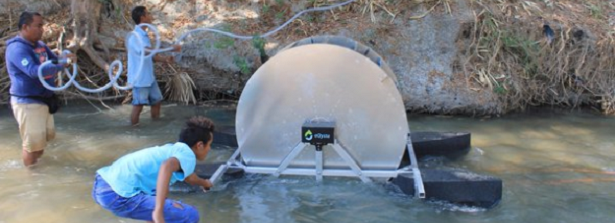Enabling Access to Sustainable Irrigation with EASI-Pay for Barsha pumps in Indonesia

Duration: 01 January 2017 to 30 June 2019
Project information
Aim: This applied research “Enabling Access to Sustainable Irrigation: Pay-per-harvest Irrigation Service for Barsha pumps in Indonesia (EASI-Pay)” addresses the barrier to pay for the upfront costs of the Barsha pump in Sumba, one of the driest islands in Indonesia. Agriculture is limited to some valleys next to rivers, mostly during the rainy season. Enhancing food-security by enabling year-round farming requires pumping water from the river. However, common available solutions such as diesel pumps are too costly for smallholder farmers on islands. Barsha pumps are hydro-powered pumps, not using any fuel or electricity, so operating costs are zero. The demonstration of two Barsha pumps in 2015 raised interest among smallholder farmers. There is willingness to pay, however the upfront costs of the pump are too high to be covered from savings, especially for women with aspiration to become commercial farmers as their husbands migrate to find jobs in other islands. This applied research addresses this barrier by piloting the Pay-per-harvest irrigation service and studying risks and barriers that must be addressed to scale the model to empower other smallholders, especially women.
Objectives: The objective of the research is to establish a financing mechanism that would help in creating access to environmentally friendly irrigation technology to small-holder farmers, to enable year-round farming, which will enhance income level and food and nutrition security of the people, without damaging the environment. Furthermore, the research stresses on developing suitable financing mechanisms which would enable farmers to pay for the solution, rather than giving away the technologies for free.
Method: The overarching research question of this project is: Does the ‘pay-per-harvest’ model increase ‘willingness to pay’ and ‘ability to pay’ for the Barsha pump? In order to answer this main question, several sub-questions with associated activities need to be performed:
- Sub-theme I: Design and Implementation of the pay-per-harvest approach.
- Sub-theme II: Modalities of and potential barriers to implementation.
Country: Indonesia.
Dutch policy goals: Eradicating existing hunger and malnutrition (‘people’); Promoting inclusive and sustainable growth in the agricultural sector (‘profit’); and Creating ecologically sustainable food systems (‘planet’).
Progress reports
Year 1: Key Results: During the first year we have piloted the pay per harvest irrigation service with 105 smallholder farmers in 5 villages in Sumba Island, Indonesia. These farmers are among the most constraint farmers of Indonesia (and the world) with an average per capita income ranging between 100-150 euro. Farmers in these 5 villages used the Barsha Pump to cultivate cash crops during the dry season. Something innovative because dry season farming has not been practised before due to the labour-intensive process of watering the crops 5 hours per day. The Barsha Pumps provided the villagers the opportunity to: (i) diversify their diet, and (ii) increase income. And with success. A total of 2,814 kg respectively of red onion (476 kg), pakcoy (1,024 kg), pitcay (23 kg), tomato (315 kg), spinach (231 kg), mustard (562 kg), bitter melon (3 kg) and cabbage (180 kg) were harvested.
One third was consumed at household level (worth 556 euro) and two third was marketed, generating an income of 1,400 euro. A total of 312 euro (16% of the harvest value) was repaid for the irrigation service. On average, this meant an 8-13% increase of per capita income. This increase was very welcomed by the villagers – in particular by those piloted of Mbatakapidhu 1 and 2, who saw their harvest being tripled when compared to last season – given the fact that each village had, by means of pilot, only irrigated 0.13 hectare (while the Barsha Pump has the capacity to irrigate between 1 to 2 hectares). Keeping this in mind, the villagers calculated that they could increase their per capita income with 154 euro per year (an 100% increase of per capita income) when using the Barsha Pump to its full capacity. This has led to the full commitment of the villagers (and their leaders) to irrigate the upcoming dry season at least 1 hectare of land. This, together with more training on the cultivation of high value crops (e.g. red onion), will lay a good foundation to: (i) improve villager’s wellbeing by means of a higher income and more diverse diet, and (ii) achieve a financial sustainable pay per harvest irrigation service in which the pumps are being repaid within 3-4 years.
